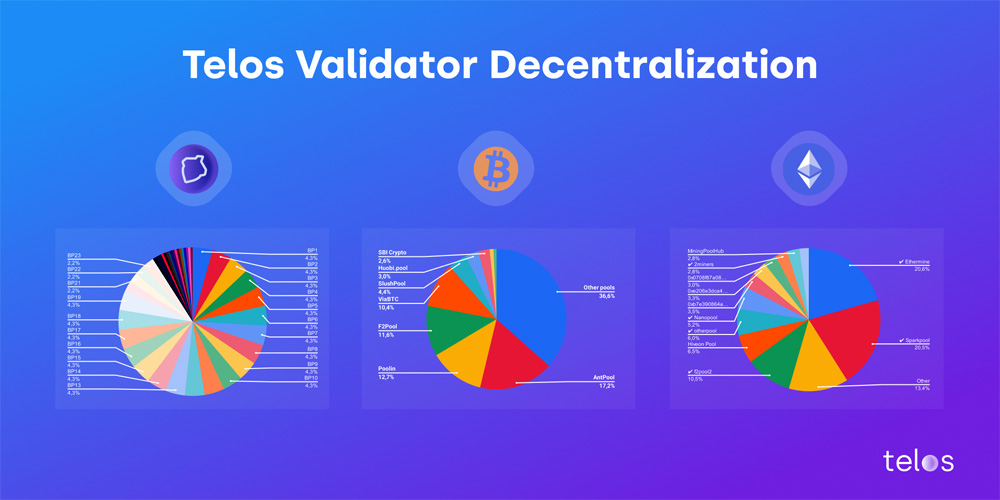 New York, Warta9 – Telos Blockchain (ticker: TLOS), the world’s most robust and decentralized ESG compliant layer 1 platform and home to the world’s fastest, highest capacity EVM (tEVM), derives credible neutrality and decentralization from at least 42 equally distinct validating nodes compared to the much smaller number of major mining pools securing Bitcoin and Ethereum.
New York, Warta9 – Telos Blockchain (ticker: TLOS), the world’s most robust and decentralized ESG compliant layer 1 platform and home to the world’s fastest, highest capacity EVM (tEVM), derives credible neutrality and decentralization from at least 42 equally distinct validating nodes compared to the much smaller number of major mining pools securing Bitcoin and Ethereum.
After a thorough competitive analysis comparing Telos’ decentralization to the decentralization of many of the other top Layer 1 chains, the Foundation has confirmed its assumptions. Based on validator equality and crucial factors regarding architecture and finances, the team confirmed that Telos is indeed one of the leading chains regarding credible neutrality and decentralization.
As mining pools lack equality, massive node counts become irrelevant: As depicted in the pie charts above, Telos, via its governance, has maintained an equitable distribution amongst all its active validators and Bitcoin and Ethereum have not. Instead, the mining pools of both Bitcoin and Ethereum have now become centralized. in a press release received by the editor of warta9, Wednesday April 20 2022.
The hypothesis is that over the years the well-funded pools have overtaken the little ones. Despite the substantial number of nodes, to be a credibly neutral peer-to-peer network, the network must also sustain even splits in validator power / responsibilities. Without this equality, the insulating strengths of decentralized peer-to-peer networking becomes significantly degraded.
A decentralized network made up of equitable validators adds a powerful layer of insulation against multiple scenarios. For example, a multi-government coalition could potentially implement disruptive regulations or restrictions on blockchain.
If only a handful of validators / mining pools need to be targeted, it becomes much easier for those governments to impose their will and degrade the insulation that a peer-to-peer network is supposed to provide.
In fact, an event far smaller than this could instantly interrupt some chains from operating as they intended. However, the problem is not just limited to government interference. It is also the potential of a coalition amongst the validator majority that threatens the decentralization and stability of a chain.
Despite having many nodes, it appears that for Bitcoin it would take only ~5 large mining pools to form a majority, only ~4 for Ethereum and 22 for Telos (as depicted in the pie charts above).
Aside from this significant (4x to 5x) difference, it is also worth noting that the community fairly votes the Telos validators into active slots vs Bitcoin / Ethereum in which the mining pool’s principles are anonymous and can simply buy their way into a majority position. Hence, the centralization and lack of credible neutrality that has now formed. Credible neutrality cannot exist in an environment in which control and influence is exerted by small groups of well-funded people.
This move towards validator centralization also leads to neutrality questions that are impossible to answer. For example, are the validator majorities’ ambitions in line with what is best for the chain or themselves? To put the potential gravity of this into perspective one needs to understand that the principal/s of a majority sized mining pool can easily be a crime syndicate, and no one would know about it due to the anonymity.
In fact, all the major mining pools can hypothetically be owned by crime syndicates, and no one would ever know. In contrast to this, with chain-governed validator equality and ongoing fair community voting, these credibility and neutrality questions are simply non-existing issues.
In fact, all these chain degrading scenarios are exactly what the Telos architecture and governance have insulated against. As a chain’s validator network becomes unequal in size; the more it will move towards centralization, the more its neutrality will become biased and the more these chain breakdown scenarios may become a reality.
Insider allocation cost blockchain’s their credible neutrality: Being that Telos was a 100% bootstrap project (95% of the coins airdropped to the community, 5% were used as equal pay to the almost 150 contributors, no insider handouts, and no ICO), the team already knew that its insider allocation was at the same level as Bitcoin’s beginnings, zero.
Telos is the only L1 chain besides Bitcoin to have ever reached this stage of maturity while still maintaining zero insider allocation. All the other L1 chains are believed to be centralized and unable to become credibly neutral public infrastructure due to their insider allocation (click here to see).
With this being noted, these chains will most likely never be utilized by governments as a legal tender and dApps depending on this infrastructure will never be 100% insulated by the full power of credible neutrality and decentralization.
Telos Decentralization: Since its inception, the validators of the Telos Blockchain are both equally sized and regionally / globally diversified. Plus, no ungoverned wallet is known to hold more than 2% of the chain. From chain architecture to finances, decentralization and neutrality are of the highest priority for the chain.
Over the last 4 years, Telos has grown into a truly utopian blockchain option for both private and public infrastructure. It is ludicrously fast, very inexpensive, extremely energy efficient, credibly neutral, non-congested, super easy to deploy on and the only chain that fully insulates the public from the front running / MEV that is plaguing Ethereum. (**)



































